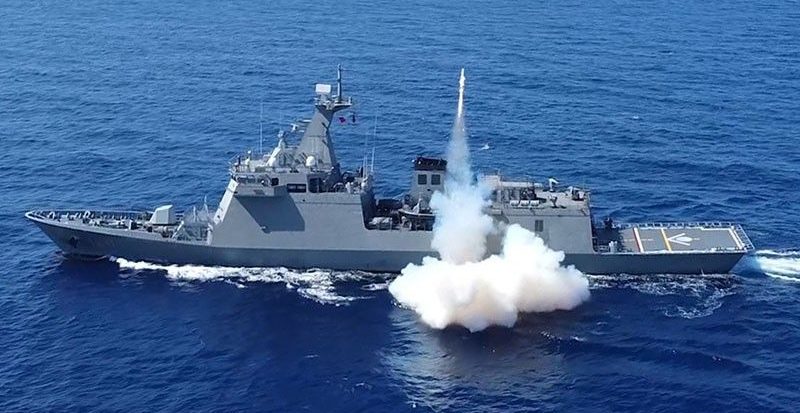AFP airs concern over China aircraft carrier group in PH sea
Aside from monitoring the situation in the West Philippine Sea (WPS), defense officials are also keeping a watchful eye on the latest movements of Chinese military vessels and aircraft in another part of the archipelago.
The Armed Forces of the Philippines expressed concern on Wednesday over the presence of a Chinese carrier strike group in the Philippine Sea, the body of water on the country’s eastern side, opposite the WPS.
The strike group, led by the Chinese aircraft carrier Shandong, passed through the Balintang Channel around dawn on Wednesday on its way to drills in the West Pacific. Its movement was also reported by the Taiwanese defense ministry, which said it had detected 36 Chinese military aircraft heading in the same direction to join the Shandong.
Balintang Channel is located between the northernmost Philippine province of Batanes and the Babuyan Islands in Cagayan.
The AFP “notes the deployment of a Chinese carrier strike group in the Philippine Sea with concern,” said its spokesperson, Col. Francel Margareth Padilla. “The AFP remains committed to safeguarding our maritime interests and ensuring the security of our nation’s territorial waters through continued vigilance.”
First time this year
“We emphasize the importance of maintaining peace and stability in the region and urge all parties to adhere to international laws and norms,” Padilla added.
According to a report by the United States Naval Institute (USNI), Wednesday’s sightings marked the first time this year that a Chinese carrier strike group was deployed outside the South China Sea.
USNI said the last deployment of the Chinese carrier strike group to the Philippine Sea was in November and October last year.
The Shandong was also spotted sailing within 370 kilometers (230 miles) off the western side of Luzon Island on June 26.
Taipei monitoring
In Taipei, the Taiwanese defense ministry said starting around dawn on Wednesday it had detected 36 Chinese military aircraft, including J-16 fighters and nuclear-capable H-6 bombers, flying to the south and southeast of the island heading to the Western Pacific to carry out drills with the Shandong.
Speaking to reporters at parliament shortly before his ministry announced details of the latest mission by the Shandong, commissioned by China in 2019, Taiwan Defense Minister Wellington Koo said they had a “full grasp” of the ship’s movements.
“It did not pass through the Bashi Channel,” he said, referring to the waterway that separates Taiwan from the Philippines and is the usual route Chinese warships and warplanes take when they head into the Pacific.
China-Russia drills
“It went further south, through the Balintang Channel, to the Western Pacific,” Koo added.
China’s defense ministry did not immediately respond to a request for comment.
Late Tuesday, Japan’s Self Defense Forces said they detected the Shandong along with an escort of two missile destroyers and a frigate around 500 km (310 miles) south of its Okinawa islands.
Two Japanese navy ships were observing their movements while Japanese fighter jets scrambled in response to the aircraft launched by the carrier, it said in a statement.
In a separate AFP statement on Wednesday, Public Affairs Office chief Col. Xerxes Trinidad said the military had received reports about a “bilateral China-Russia exercise” also in the Philippine Sea.
“What they do in the high seas is being monitored,” Trinidad said a day after Moscow’s participation in the drills was reported by the Russian state news agency TASS.

PH Rise patrol
“We will continue to monitor this situation to ensure Philippine sovereign rights are not violated,” Trinidad said.
On Tuesday, the BRP Jose Rizal, the Philippine Navy’s first guided-missile frigate, sailed to the Philippine Rise—a major marine feature in the Philippine Sea for a “sovereignty patrol” over the resource-rich underwater plateau formerly known as Benham Rise.
In his sendoff message at Poro Point in San Fernando City, La Union, Commodore Edward Ike de Sagon, commander of the Naval Forces-Northern Luzon, said the patrol was intended to “sustain marine conservation and protection of the Philippine Rise, reaffirm sovereign rights and raise awareness of its strategic value.”
The submerged landmass was renamed in May 2017, during the term of then President Rodrigo Duterte, to emphasize its designation as a “protected food supply exclusive zone” of the Philippines.
According to Duterte’s Executive Order No. 25, the country has sovereign rights and jurisdiction over the area in accordance with the 1987 Constitution, national legislation, the United Nations Convention on the Law of the Sea, and applicable international laws.





















